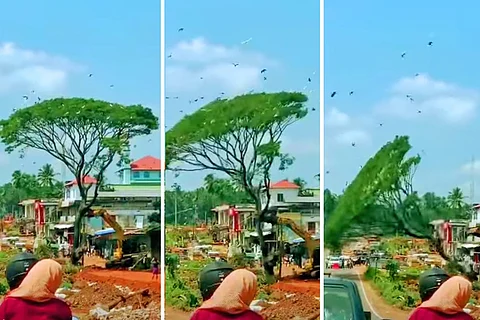

A video of a decades-old tree teeming with nesting birds being uprooted on National Highway 66 in Randathani in Kerala’s Malappuram district had shaken the conscience of environmentalists and citizens in the past week. The video showed numerous birds taking off, as an earthmover pushed down the tree they had nested in, near a national highway development site. Migratory birds were among those affected in Randathani. Several trees like the one in the video have been marked to be felled as part of a highway widening initiative of the National Highway Authority of India (NHAI).
Environmentalists and bird watchers have come forward to say that the expansion should be paused until after the nesting season. Bird watchers say that most birds, including migratory varieties, nest and lay eggs around the monsoon. The low temperatures and abundance of food during the monsoon are the major reasons for this. The hatchlings take between four and five months to mature. When a nesting tree is felled, the adult birds escape, while unhatched eggs and hatchlings fall to the ground and die.
Malappuram is one of the five north Kerala districts that have a significant heronry (a colony of herons) presence. Surveys conducted with the cooperation of the Kerala Forest Department have established that twelve species of waterbirds breed in the region. According to the paper ‘Long term Monitoring of Heronries in North Kerala, India: A Synthesis,’ authored by Dr Roshnath Ramesh, a major share of the heronries are located along national and state highways. The paper observes that high-density human populations in these areas make the birds prone to anthropogenic disturbances. Among the species that nest in the area are the near-threatened Ibis (Threskiornis melanocephalus) and Oriental Darter (Anhinga melanogaster).
Srinila K T, research scholar and Malappuram district coordinator of the heronry survey, identified the birds displaced in Randathani as egrets and little cormorants. Heronries in north Kerala are concentrated in public spaces like bus stands and railway stations, observed birdwatcher Manoj Karingamadathil. According to Srinila, the birds’ preference for urban public spaces is preferred due to the greater chance of avoiding predatory birds and terrestrial predators.
She explained that sudden destruction of a regular heronry site during the nesting period will affect the population of the species. According to Manoj, “When a nesting tree is felled, a whole batch of birds is lost. This will have micro-level impacts on the species. Had the same tree been cut two months later, this problem could have been avoided.” He felt that such incidents occur because those undertaking development initiatives are ignorant of the breeding cycle of birds and the legal provisions protecting them.
The Wild Life Protection Act prohibits the hunting of any wild animal except for certain cases exempted by law. The Act’s definition of hunting, includes damaging or disturbing the eggs or nests of birds. The birds displaced in Randathani belong to the fourth schedule of the Act. The contravention of the provisions of the Act are “punishable with imprisonment for a term which may extend to 3 [three years], or with fine which may extend to 4 [twenty-five thousand rupees], or with both.”
Both Manoj and Srinila confirmed that the birds affected in Randathani fall in IUCN’s least concern category, reducing the incident’s impact. Even for such species, finding a new nesting site in the next breeding cycle will involve several hardships including higher threat of predators, Srinila added. According to her, several other trees in Randathani that used to serve as regular heronry sites had been felled a few months back. This could have led to a higher number of breeding pairs choosing the tree felled this week for nesting in the current season.
Emphasising the need for letting young birds mature, Thomas Lawrence, CEO of the Save Wetlands International Movement (SWIM), wrote to Minister of Road Transport and Highways Nitin Gadkari on Saturday, August 6. His email sought the Minister’s prompt intervention in the matter as it is understood that more trees will be felled in this area in the coming days. Speaking to TNM, Thomas said that development projects such as this should be sensitive towards the ecological impact they have. “The tree felling should have been undertaken after due consultation with ornithologists and other experts on the breeding patterns of the birds and other rehabilitation measures that could have been taken,” he said. But rescue and rehabilitation is no small task, Srinila cautioned. “If a single pair of adult birds were to have at least three to four young ones, with thirty such units on a tree, that would mean 120 eggs and/or hatchlings to rescue if the tree is felled. Even if a rescue initiative is undertaken, survival rates will be very low,” she added.
This is not the first time that Thomas has written to Gadkari. In 2017, he had requested the Minister’s intervention in removing a bund that separated the Veli-Akkulam lake system in Thiruvananthapuram following the construction of a bridge here by the NHAI. “I received a response within four hours. I am hopeful that the Minister will act swiftly in the current case too.”
A similar incident in Uttar Pradesh’s Buduan had led to the arrest of three persons on August 5. The forest department there took action following the intervention of MP Maneka Gandhi in an incident where nesting birds on a tree died after its illegal felling. The accused were booked under Sections 4 and 10 of the Forest Conservation Act. Closer home in Palakkad, railway officials were arrested in October 2019, after a Gulmohar housing the nests of over 100 migratory birds was felled. The tree was cut as part of a project to expand the Palakkad railway station’s parking area.